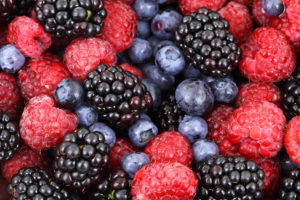 Where I live in Oregon, I’m happily surrounded by a prolific selection of fresh berries— those in the wild and commercially grown. My childhood was rich with berry foraging while playing in the woods—red and blue huckleberries, salmon berries, thimbleberries, elderberries and blackberries. And living in Oregon, we are rich in thousands of acres of commercially grown berries- strawberries, red raspberries, black cap raspberries, blue berries, boysenberries, gooseberries, mulberries, loganberries and marionberries, the state berry. Yes, people make pies, ice cream, beer, liquor, wine and jams…but the real beauty is the berry itself. And when you can go out on a summer day or evening and pick fresh from the wild or the field…there is no other simple pleasure quite like it.
Where I live in Oregon, I’m happily surrounded by a prolific selection of fresh berries— those in the wild and commercially grown. My childhood was rich with berry foraging while playing in the woods—red and blue huckleberries, salmon berries, thimbleberries, elderberries and blackberries. And living in Oregon, we are rich in thousands of acres of commercially grown berries- strawberries, red raspberries, black cap raspberries, blue berries, boysenberries, gooseberries, mulberries, loganberries and marionberries, the state berry. Yes, people make pies, ice cream, beer, liquor, wine and jams…but the real beauty is the berry itself. And when you can go out on a summer day or evening and pick fresh from the wild or the field…there is no other simple pleasure quite like it.
Native Americans had deep knowledge of the many varieties growing wild in the woods and fields, using them for not only eating fresh and cooked, but also drying them to eat during the long wet and cold winter months.
The term “berry” refers to any small edible fruit that is usually juicy, colorful, sweet or sour and some with small seeds although no pit. This is the common usage of the term, berry. The botanical definition of a berry is a fleshy fruit derived from the ovary of a single flower which botanically, includes tomatoes, avocados, eggplants, grapes, watermelons and bananas. And, by this definition, blackberries, raspberries, mulberries and strawberries are not. But let’s not be distracted by what we really think of as berries.
Berries provide vitamin C, potassium, beta carotene, folate, soluble and insoluble fiber, flavonoids and polyphenols. These flavonoids and polyphenols are really the shining star plant substances of berries. These flavonoids and polyphenols are rich in antioxidant properties and specific flavonoids, such as the quercetin and kaempferol high in raspberries, and the ellagic acid rich in raspberries and blackberries.
There have been a number or randomized controlled trials looking at the health effects of specific berries. Between these human studies and laboratory studies, bioactive compounds in the berries have anti-inflammatory, anticancer, immune regulating and other properties.
Many of these studies have shown that eating flavonoid-rich fruit regularly may play a role in delaying age-related neurodegenerative diseases like Alzheimer’s disease. This is especially notable for women. In our 60s we’re twice as likely to develop Alzheimer’s than men.
Men can of course benefit from eating berries too. In one study, it was found that obese men aged 50-75 who consumed one cup of freeze-dried powdered blueberries a day for six months had improvements in blood vessel function. Those who were in the blueberry group and not the placebo group had increases in the good cholesterol, HDL. In another study, 21 overweight or obese individuals with prediabetes were compared to overweight or obese individuals who did not have prediabetes. When the folks in the prediabetic group ate one or two cups a day of red raspberries for three days, their blood sugar control improved compared to those who did not eat the berries. Another study showed greater fat burning and improved insulin sensitivity in those who were overweight or obese by eating 21 ounces daily of blackberries for seven days. Even knee osteoarthritis improved in pain symptoms after consuming a freeze dried 50 gm/day strawberry beverage for 12 weeks. Even elderberry extract consumers had shorter and less severe colds after overseas flight travel.
The best bet is to buy or pick fresh berries. If they are harvested when ripe, this is when the taste the best. When they are picked unripe (which is too often the case with store bought strawberries in particular), they don’t get sweeter after picking due to the low starch in the berries. If you want berries year-round, better to freeze the berries when they are in season than buy off season fresh ones.
It’s also important to be mindful of organic vs. not organic. Organic blueberries have been shown to have a higher antioxidant value than non-organic. Non-organic strawberries and domestic blueberries are on the “dirty dozen” list, which means they tested positive for 47-67 different chemicals. And, there are no berries on the “clean 15” list of non-organic fruits and vegetables.
Enjoy the rest of the summer—pick, eat as snacks or in fruit salads or fresh smoothies and freeze. Come fall to late spring, you will be oh so happy to see them in your freezer. All the while, giving your body foods rich in the healing properties of flavonoids and other polyphenols.

